

02/27/2012

From Ref. 1 © 2011 S. Souma
Topological insulators are some of the most promising electronic materials available, because they allow the use of the electron’s magnetic property — its spin — for enhanced low-loss computing technology. This advantageous property is based on energy states at the surface, where electrons propagate in a similar way to particles that have no mass. Takashi Takahashi, Seigo Souma and co-workers from WPI-AIMR, with colleagues from Tohoku University’s Physics Department and Osaka University, have now made the surprising discovery that in some topological insulators these electrons at the surface state can also show mass, which leads to entirely new effects for spin electronics1.
The difference between normal electrons and those in the surface states of topological insulators is that the latter show ‘time-reversal symmetry’, which means, for example, that if the motion of electrons was filmed with a camera, the film would always look the same, whether it is played forwards or backwards. This time-reversal symmetry is at the core of many attractive properties of topological insulators, including their protection against losses. One feature of this symmetry is that the surface energy states show a characteristic X-shape when electron energy is plotted against momentum (see image).
The researchers have now studied how this X-shape evolves in the topological insulator, thallium–bismuth–selenium. The experiments were performed on an angle-resolved photoemission spectrometer at the WPI-AIMR, which currently has the highest available energy resolution in the world. During the evolution, selenium atoms are increasingly replaced by sulfur. Because the sulfur analogue, thallium–bismuth–sulfur, is not a topological insulator, the replacement of selenium by sulfur enables the tracking of the transition from a topological insulator to a classical insulator.
With increasing sulfur content, the surface energy states slowly begin to lose their X-shape and a gap opens up in the center of the ‘X’. This means that the electrons no longer appear massless. “There are predictions that topological insulators with a gap show a coupling between magnetic and electronic effects, the strength of which is independent of the material,” explains Souma. This could be of particular relevance to information storage technologies, because such an effect allows the control of magnetic information with electrical fields.
The present study makes a compelling case for the technological importance of topological insulators, which continue to be one of the most intensively studied materials today. “Our next step will be to study the origin of this energy gap, which remains poorly understood,” says Souma, adding that an experimental demonstration of the predicted novel effects will also be important.
Sato, T., Segawa, K., Kosaka, K., Souma, S., Nakayama, K., Eto, K., Minami, T., Ando, Y. & Takahashi, T. Unexpected mass acquisition of Dirac fermions at the quantum phase transition of a topological insulator. Nature Physics 7, 840 (2011). | article
This research highlight has been approved by the authors of the original article and all information and data contained within has been provided by said authors.